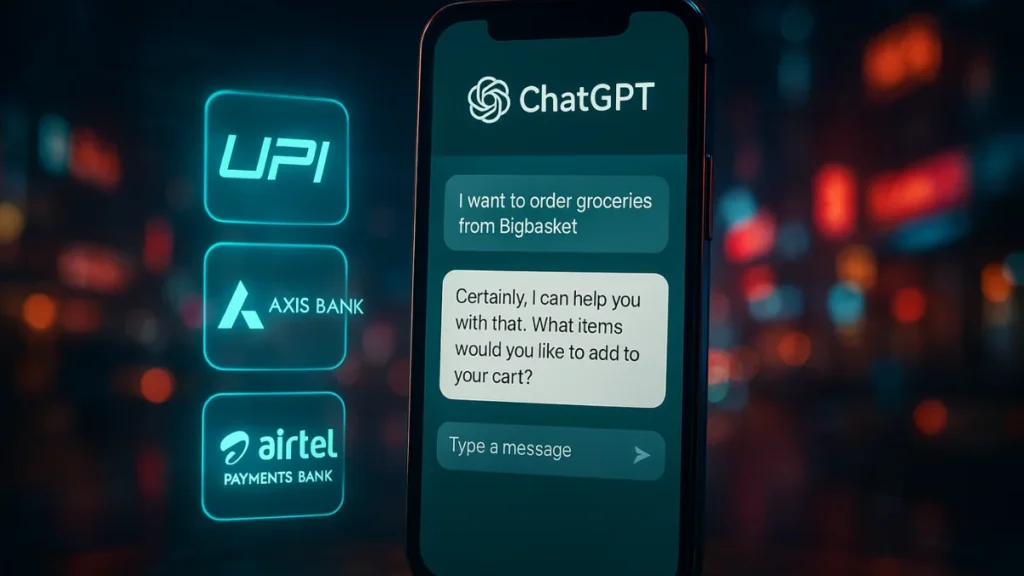India is testing a new frontier: shopping and paying directly through ChatGPT.
In partnership with NPCI and Razorpay, OpenAI is launching a conversational commerce pilot that could reshape India’s digital payments landscape.
Key Takeaways
- India is piloting AI-driven e-commerce using ChatGPT + UPI.
- Bigbasket and Vi are among first merchants onboarded.
- Bank partners include Axis Bank and Airtel Payments Bank.
- Google’s Gemini and Anthropic’s Claude integrations are in proof-of-concept stage.
- AI firms will not access user payment data; security and control retained by users.
India’s payments regulator NPCI and fintech Razorpay have teamed up with OpenAI to pilot a system allowing users to shop and pay directly via ChatGPT using UPI. Bigbasket, Vi, Axis Bank and Airtel Payments Bank are early partners.
India’s bold step: Chatbots as shopping agents
India’s National Payments Corporation (NPCI) has launched a pilot enabling users to complete e-commerce payments within ChatGPT, via UPI (Unified Payments Interface).
The project is built on NPCI’s new protocols—UPI Reserve Pay (which pre-locks funds for future debits) and UPI Circle (delegated authentication)—to allow AI agents to handle callbacks without redirecting users to external apps.
Razorpay developed the merchant integration layer.
The Indian pilot is already nationwide in testing and will scale in coming months, according to Razorpay.
Who’s in the pilot — and how it works
Merchant side:
Tata Group–owned Bigbasket (groceries) and telecom operator Vi are among the first merchants enabling shopping via ChatGPT.
Banking side:
Axis Bank and Airtel Payments Bank serve as the banking partners powering the transaction flow.
AI integrations ahead:
Razorpay says they have proof-of-concept integrations ready for Google’s Gemini and Anthropic’s Claude. These are expected to go live in coming weeks.
Even so, the initial launch is ChatGPT-centric.
Why this matters
India already runs one of the world’s largest and most active digital payment networks: UPI handles over 20 billion transactions per month.
By embedding commerce into conversational AI, NPCI aims to further entrench UPI into daily consumer behavior.
This also gives global AI firms a stronger localization anchor: Deep integration with India’s payment rails could raise retention and user stickiness.
From a consumer perspective, the promise is: shop, compare, checkout—all without leaving the chat window. Mint describes the envisioned flow (e.g. “Help me order ingredients … from BigBasket”) as seamless in-chat ordering.
However, security is front of mind: the AI firms will not get access to raw payment data. Users must pre-authorize transactions via two-factor authentication.
Risks & industry response
Data privacy & control:
Despite safeguards, handing over checkout flows to AI agents raises sensitive questions—especially given how opaque algorithmic decisions can be.
Regulatory scrutiny:
India is already ramping biometric authorizations for UPI (face/fingerprint) as an alternative to PINs.
Any AI-payment system will likely attract close oversight from NPCI and the Reserve Bank of India.
Merchant adoption & costs:
Razorpay is engaging with more merchants; scale will depend on how easily commerce brands can plug into this system.
Monetization models remain unclear: for now, AI firms aren’t slated to earn from transaction data.
User trust hurdles:
Consumers may resist letting bots auto-checkout, especially in a market with frequent concerns about scams and fraud.
Global implications & competitive ripple
If India’s experiment succeeds, it could become a benchmark for conversational commerce worldwide: AI agents that not only guide but execute.
OpenAI has already rolled out Instant Checkout and an Agentic Commerce Protocol (with Stripe) in other markets; Google launched its own Agent Payments Protocol.
For Google and Anthropic, integrating their agents with this India pilot could help them clamp a stronger presence in South Asia—strategically critical given the region’s growth.
What’s next — rollout, watchpoints
- Tactical rollout to more merchants and verticals in the next months.
- Activation of Gemini and Claude agent payments.
- Regulatory clarifications on liability, data use, and security standards.
- Consumer adoption curves—how many users will trust AI for actual shopping?
Conclusion
India’s AI-led payments pilot via ChatGPT is a bold experiment at the intersection of conversational AI and real-time payments. If it works, it can lower friction in e-commerce dramatically. If it fails or faces resistance, it could slow AI’s push into day-to-day consumer flows.
